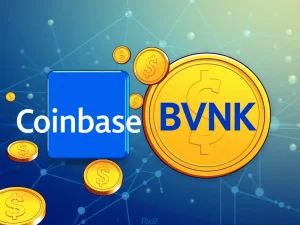Epic Leap: Mainstream Crypto Adoption Set to Welcome 5 Billion Users

The digital frontier is expanding at an unprecedented pace. Imagine a world where digital assets are as commonplace as credit cards. This future, many industry leaders believe, is not far off. Mainstream crypto adoption is poised for an epic leap, potentially welcoming 5 billion crypto users within the next decade. Experts from leading platforms like Crypto.com and OKX foresee a pivotal shift. They suggest the Web3 industry stands on the brink of widespread acceptance, driven by the upcoming next bull cycle and significant advancements in blockchain growth.
The Dawn of a New Era: 5 Billion Crypto Users on the Horizon
The cryptocurrency industry is rapidly evolving. It moves beyond niche interest to the cusp of global integration. Thomas Prévot, head of operations in France at Crypto.com, made a bold prediction at Waib Summit 2025 in Monaco. He stated, “Within 10 years, we’ll reach 5 billion users.” This figure signifies a monumental shift. It positions digital assets as a universally accepted payment method. Prévot emphasizes that we are merely “one growth cycle away from full mainstream adoption.” This is not merely about reaching 1 billion users. It is about achieving a scale where crypto is used as ubiquitously as credit cards today. This vision aligns with the foundational principles of Web3.
The current landscape shows significant progress. Crypto.com’s December research report from 2025 estimated 659 million crypto users at the end of that year. This number highlights a robust and growing base. However, the path to 5 billion is ambitious. It requires overcoming various hurdles and capitalizing on key opportunities. The next major wave of adoption, according to Prévot, will likely follow a market recovery. This will occur at the beginning of the next bull cycle. Such a surge would establish cryptocurrencies as a genuine alternative payment system. This fulfills Satoshi Nakamoto’s original vision for Bitcoin (BTC). Nakamoto aimed to create a censorship-resistant, peer-to-peer transaction tool.
Catalysts for Unprecedented Blockchain Growth
Achieving the ambitious goal of 5 billion crypto users relies on two primary drivers. Roy van Krimpen, general manager for Western Europe at OKX exchange, outlined these pathways. He explained that “getting to a billion can happen in one of two ways.” The first, and often most immediate, is retail price speculation. We saw this phenomenon dramatically in 2021. During that period, the market more than quadrupled in a few months. This was largely due to the influx of retail investors driven by the promise of high returns. Price movements frequently attract new participants. Therefore, a robust next bull cycle could once again spark massive retail interest. This would quickly onboard millions of new users.
The second, and arguably more sustainable, pathway involves the actual usage of blockchain technology. This includes applications like payments, decentralized finance (DeFi), and other Web3 initiatives. This method requires a fundamental shift in consumer behavior. Such changes typically take longer to materialize compared to speculative trends. However, they promise a deeper, more ingrained form of adoption. Chintan Turakhia, senior director of engineering at Coinbase, echoes this sentiment. He believes that improved blockchain application usability and beginner-friendly interfaces are crucial. These factors are key to attracting the first billion, and subsequently, the next several billion crypto users. Therefore, developers and platforms are focusing on creating intuitive experiences.
The Dual Engines: Speculation and Utility Driving Mainstream Crypto Adoption
The journey towards mainstream crypto adoption is propelled by a dynamic interplay between speculation and practical utility. While price rallies undeniably draw in new participants, the long-term sustainability hinges on real-world applications. Understanding these dual engines is essential for predicting future growth.
1. The Power of Speculation:
- Historical Precedent: The 2021 market cycle clearly demonstrated the power of speculation. Bitcoin and altcoins saw unprecedented gains. These attracted millions of new investors eager to participate.
- FOMO (Fear Of Missing Out): Significant price increases often trigger a “fear of missing out.” This psychological factor encourages rapid onboarding of new users. They wish to capitalize on perceived opportunities.
- Gateway to Crypto: For many, initial exposure to crypto comes through speculative investments. They buy a small amount of Bitcoin or Ethereum. This first step can then lead to deeper engagement with the ecosystem.
- Market Cycles: Speculation is inherently tied to market cycles. Bull markets fuel excitement and investment. Conversely, bear markets often see a reduction in new speculative interest. However, these periods can also be times of building and consolidation.
2. The Promise of Utility:
- Seamless Payments: Imagine using crypto for everyday purchases with the same ease as a credit card. This vision, articulated by Thomas Prévot, is a core driver for blockchain growth. Companies are developing faster, cheaper, and more user-friendly payment solutions.
- Decentralized Finance (DeFi): DeFi offers alternatives to traditional banking. It provides lending, borrowing, and trading without intermediaries. As these platforms become more accessible, they will attract a broader user base.
- Web3 Applications: The broader Web3 ecosystem, encompassing NFTs, decentralized social media, and gaming, provides new use cases. These applications offer enhanced ownership and user control. This appeals to a generation seeking digital autonomy.
- Beginner-Friendly Interfaces: Simplifying the user experience is paramount. Exchanges like Crypto.com and OKX invest heavily in intuitive apps. They aim to reduce the technical barriers for new crypto users.
Both speculation and utility contribute to mainstream crypto adoption. Speculation often acts as the initial spark. Utility provides the long-term value and reason for sustained engagement.
Bitcoin’s Role and Price Predictions in the Next Bull Cycle
Bitcoin (BTC), as the pioneering cryptocurrency, plays a crucial role in the narrative of mainstream crypto adoption. Its status as “digital gold” and its limited supply make it a primary asset for institutional and retail investors alike. As the industry matures, Bitcoin’s potential for price appreciation remains a significant draw.
Popular Bitcoin analyst Willy Woo, in August 2024, predicted an “ultimate price” of $700,000 per token for Bitcoin. This forecast is based on an assumed 3% portfolio allocation by investors. Such a valuation would undoubtedly signal massive blockchain growth and widespread acceptance. It suggests that a significant portion of global wealth would flow into the digital asset space. While this figure is speculative, it highlights the immense potential seen by industry experts.
The next bull cycle is widely anticipated to be a catalyst for Bitcoin’s next major price surge. Historically, Bitcoin’s price movements often lead the broader crypto market. Its performance can influence sentiment across the entire ecosystem. Therefore, a strong Bitcoin rally could ignite renewed interest in altcoins and the wider Web3 space. This would draw in more crypto users. Institutional investment is also expected to play a larger role. As regulatory clarity improves, more traditional financial institutions may allocate funds to Bitcoin. This further solidifies its position as a legitimate asset class.
Navigating the Path to Mass Adoption: Challenges and Solutions for Web3 Adoption
While the vision of 5 billion crypto users is compelling, the path to Web3 adoption is not without its challenges. Overcoming these hurdles is critical for realizing the full potential of mainstream crypto adoption. Industry leaders are actively working on solutions.
Key Challenges:
- Regulatory Uncertainty: The lack of clear, unified regulations across different jurisdictions remains a significant barrier. Businesses and investors need certainty to operate and invest confidently. Governments worldwide are grappling with how to regulate digital assets.
- Technical Complexity: For many newcomers, the concepts of private keys, seed phrases, gas fees, and blockchain networks can be daunting. This complexity hinders easy entry for non-technical users.
- Security Concerns: High-profile hacks, scams, and phishing attacks erode trust. Protecting user assets and data is paramount for mass adoption.
- Scalability Issues: Some blockchain networks struggle with transaction speed and cost, especially during peak demand. This limits their ability to handle billions of users efficiently.
- Environmental Concerns: The energy consumption of certain proof-of-work blockchains, like Bitcoin, raises environmental concerns. This could deter environmentally conscious users and institutions.
Addressing the Challenges for Blockchain Growth:
- Clearer Regulations: Governments and international bodies must collaborate to establish clear, consistent regulatory frameworks. This fosters innovation while protecting consumers.
- Enhanced User Experience: Developing intuitive wallets, simplified onboarding processes, and abstracting away technical complexities are vital. Platforms like Crypto.com and OKX are at the forefront of this effort.
- Robust Security Measures: Implementing advanced security protocols, educating users on best practices, and offering insurance for digital assets build trust.
- Scalability Solutions: Layer-2 solutions, sharding, and alternative consensus mechanisms (like Proof-of-Stake) are being developed to improve transaction throughput and reduce costs. This ensures the infrastructure can support billions of crypto users.
- Sustainable Practices: The industry is exploring more energy-efficient blockchain designs and advocating for renewable energy sources for mining operations.
The Broader Impact of Mainstream Crypto Adoption
The realization of 5 billion crypto users would usher in a new era with profound global impacts. This level of mainstream crypto adoption extends far beyond financial markets. It touches various aspects of society and economy.
Economic Transformation:
- Financial Inclusion: Billions of unbanked or underbanked individuals worldwide could gain access to financial services. Cryptocurrencies offer a gateway to savings, payments, and credit without traditional banking infrastructure.
- Reduced Transaction Costs: Cross-border payments, in particular, can become significantly cheaper and faster. This benefits businesses and individuals engaged in international trade and remittances.
- New Business Models: The Web3 paradigm enables novel business models. These include tokenized economies, decentralized autonomous organizations (DAOs), and creator-owned platforms. This fosters innovation and creates new economic opportunities.
Societal Shifts:
- Digital Identity and Ownership: Blockchain technology provides secure, self-sovereign digital identities. Users gain true ownership over their data and digital assets. This empowers individuals in the digital realm.
- Enhanced Transparency: Public blockchains offer unprecedented transparency in transactions and data. This can help combat corruption and increase accountability in various sectors.
- Global Interconnectivity: Cryptocurrencies inherently transcend national borders. They facilitate a more interconnected global economy. This fosters collaboration and exchange on a worldwide scale.
The journey to 5 billion crypto users is not just about numbers. It is about fundamentally reshaping how we interact with money, data, and digital services. This blockchain growth represents a paradigm shift. It promises a future where financial access is universal and digital interactions are more secure and equitable. As the next bull cycle approaches, the momentum towards this future builds. The collective efforts of industry leaders, developers, and users will define this transformative era. The Web3 adoption movement is set to redefine our digital landscape.







